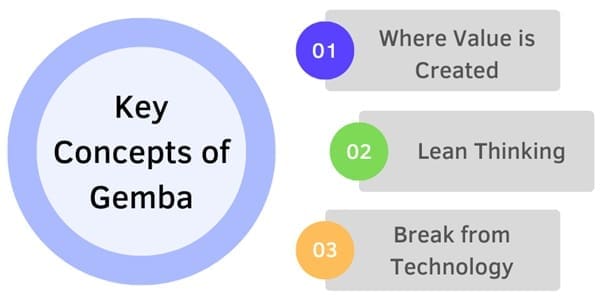Estimated reading time: 3 minutes
Gemba (also spelt genba) is a Japanese term meaning “the real place.” In everyday contexts, Japanese police refer to a crime scene as gemba, and TV reporters often report live from gemba.
In business, it refers to the place where value creation takes place. This is most commonly used in manufacturing, where the gemba is the factory floor. However, it can be any site where value creation occurs, such as a construction site, a retail sales floor, or a car dealership showroom.
Table of contents
Gemba in Business
Gemba was first used in the business context by Toyota to signify going to the real place where the action happens. Tom Peters popularized a similar concept in the 1980s with his book “In Search of Excellence,” introducing the idea of management by wandering around (MBWA). While MBWA involves managers moving around to see daily activities, Gemba walks are more focused and purposeful.
Key Concepts of Gemba
Here are a few concepts related to Gemba:

- Where Value is Created: In an industrial setting, it is often the manufacturing floor where the creation of products takes place. By visiting this place, managers can observe work processes directly, gaining new data and perspectives.
- Lean Thinking: Gemba walks help managers identify and eliminate waste in work processes, improving efficiency, company culture, and workplace safety.
- Break from Technology: Managers often spend too much time at their desks. It encourages them to leave their offices, providing opportunities for discovery and a clearer understanding of the actual work environment.
Why is it Important for Businesses?
Managers often look up to top leaders for direction in organizations that are often vertically structured. Meanwhile, value flows horizontally to customers. Gemba walks help reconcile these vertical and horizontal perspectives, allowing managers to see how value is actually created and delivered.
The Gemba Walk
The purpose of this walk is to observe what is happening on the work floor, engage with workers, and generate ideas for improvement. It’s not about immediately solving problems or correcting errors but understanding processes and gathering insights.
Approach
The three approaches are as follows:

- Engagement vs. Snooping: Managers should genuinely engage in Gemba walks, focusing on understanding the work completion instead of just monitoring employees.
- Respect and Curiosity: Approach workers with respect, ask questions and promote creative thinking. Avoid making assumptions or having preconceived notions about what you will find.
- Observation Skills: Effective gemba walks require practice. Managers will learn to identify problems, ask relevant questions, and use their observations to implement improvements.
Developing Gemba Skills
Observation takes time, effort, and patience. Managers may not feel comfortable initially, but with practice, they will gain confidence and improve their ability to observe processes productively.
What Gemba Is and Is Not
IS NOT:
- Management by walking around (MBWA), can be unstructured and sometimes ineffective.
- A method to point out negatives or correct behaviours immediately.
IS:
- Observing the place of performance of the activity.
- An opportunity to strengthen team culture.
- Observing with interest and understanding, leaving assumptions and opinions behind.
Final Words
Managers who incorporate Gemba walks into their routine can better understand and improve the processes where the creation of value takes place. This ultimately benefits both the business and its employees.


















